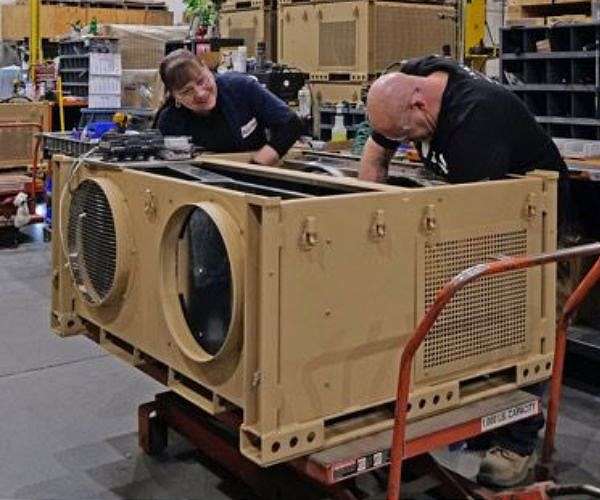Innovative solutions for climate control in military forward bases
by Clarence Oxford
Los Angeles CA (SPX) Jun 19, 2025
Ensuring stable climates in military forward bases is a formidable challenge, requiring cutting-edge solutions. The well-being of troops and the functionality of sensitive equipment depend on effective climate control. This article explores innovative approaches to regulating temperatures within military bases.
Military forward operating bases often face harsh environmental conditions, making climate control a top priority. Maintaining a stable internal environment is crucial not only for the comfort and health of personnel but also for the protection of sophisticated gear. Integrating advanced systems like the mil-spec environmental control unit ensures that these bases can adapt to varying climates, providing reliable operations in diverse terrains.
Importance of climate control
The role of climate control within military bases cannot be overstated. Extreme temperatures can impair the performance of both personnel and equipment. Troops working in excessively hot or cold environments are at risk of heatstroke or hypothermia, which can lead to diminished operational effectiveness. Sensitive electronic equipment may also malfunction if not kept within optimal temperature ranges, potentially compromising critical missions.
Effective climate regulation directly impacts troop morale and efficiency. When personnel are comfortable, they can focus better on their duties, leading to improved performance. Moreover, maintaining appropriate temperatures helps in conserving energy and extending the lifespan of equipment, which translates into cost savings over time. Thus, climate control is not just about comfort; it is a strategic necessity.
Implementing robust climate control solutions requires an understanding of the unique challenges faced by military installations. Advanced systems capable of handling extreme weather variations ensure that operations continue smoothly, regardless of external conditions. This adaptability is vital for mission success and long-term sustainability.
Modern forward operating bases
Today’s forward operating bases are designed with flexibility and resilience in mind. These facilities must be equipped to rapidly deploy and adapt to various operational demands. Modular shelter systems are increasingly being utilized due to their ease of assembly and disassembly, allowing for quick establishment or relocation as needed.
The infrastructure within these bases needs to support a wide range of functions, from housing troops to serving as command centers. This versatility demands innovative solutions that can seamlessly integrate with existing structures while enhancing their capabilities. Efficient HVAC solutions play a pivotal role in achieving this goal by ensuring consistent temperature regulation across different zones within the base.
Moreover, contemporary forward bases prioritize sustainability alongside functionality. Utilizing energy-efficient technologies reduces the logistical burden of fuel supply lines and minimizes environmental impact. The integration of renewable energy sources like solar panels further underscores the commitment to sustainable operations without compromising on effectiveness.
Integration of advanced climate control systems
The incorporation of advanced climate control systems represents a significant advancement in climate management for military bases. These units are specifically designed to meet rigorous military standards, ensuring reliability under extreme conditions. By effectively regulating temperatures, they provide a stable environment necessary for both personnel safety and equipment preservation.
The ability to maintain precise temperature control is essential for safeguarding sensitive electronics and preventing thermal-related failures. This capability is particularly important during extended deployments where resources are limited, and self-sufficiency is paramount. As such, these units form an integral part of the overall infrastructure strategy within modern military installations.
The deployment of such advanced systems highlights the emphasis placed on technological innovation in defense strategies. By investing in superior climate control measures, military forces enhance their operational readiness and resilience against environmental adversities. This approach reflects a broader trend towards leveraging technology to maintain tactical superiority on the battlefield.
Benefits of regulation
The advantages of implementing robust climate control systems in military bases extend beyond immediate operational needs. Stable internal climates contribute significantly to enhancing troop well-being by reducing stress and fatigue associated with uncomfortable temperatures. This improvement directly correlates with higher morale and increased productivity among soldiers.
Furthermore, maintaining consistent temperatures ensures that all equipment operates at peak efficiency levels without risk of overheating or freezing malfunctions. This reliability is crucial when conducting complex missions that require uninterrupted communication and data processing capabilities. Ensuring equipment longevity through proper environmental management also results in substantial cost savings by reducing maintenance requirements.
The strategic use of climate control solutions supports overall mission success by creating an environment conducive to high performance and swift decision-making processes. It allows military commanders greater flexibility in planning operations, knowing that their assets will remain functional regardless of external conditions encountered during deployments.
Related Links
Mil-Spec Environmental Control Units
The latest in Military Technology for the 21st century at SpaceWar.com



